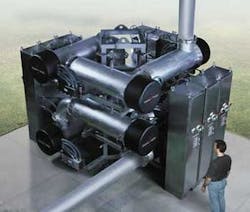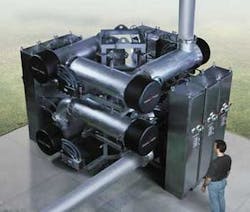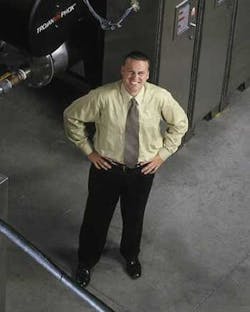UV-Oxidation disinfects water and treats chemicals simultaneously
By Christian Williamson, PhD
Ultraviolet technology now disinfects water and acts as a barrier to micropollutants in advanced water and wastewater treatment plants in Europe and North America.
Ultraviolet light can now cost-effectively treat chemicals such as N-nitrosodimethylamine (NDMA), 1,4-dioxane, and pesticides in water, in addition to disinfecting drinking water and wastewater effluent. The combination of chemical treatment and disinfection abilities makes UV a potent one-source solution.
Chemicals released into the environment threaten the quality of water supplies. Pesticides, industrial chemicals, pharmaceuticals and personal care products have been found in rivers, reservoirs and groundwater throughout the world. In a 1999-2000 survey, the United States Geological Survey found that in vulnerable watersheds downstream of urban areas and animal production, one or more investigated chemicals were detected in 80% of the samples collected. Examples of these chemicals include the faecal steroid coprostanol, the insect repellent N,N-diethyltoluamide, the pesticide diazinon, and the non-prescription drug caffeine. Many of the compounds are suspected to have endocrine disrupting potential, and if true, are harmful even at very low concentrations.
Such chemicals enter the aquatic environment through, among other means, wastewater discharge. Several studies indicate that secondary treatment is not sufficient to remove many organic compounds, including pharmaceuticals, from wastewater discharge.
Another contaminant, NDMA, is being detected in water supplies in California and is suspected to occur widely throughout the USA and the world. NDMA is a by-product of industrial processes and is formed from appropriate precursors in water treatment processes including drinking water chlorination and chloramination.
Recently recognised are the advantages of two mechanisms by which UV treats chemicals in water: photolysis and UV oxidation (UV-Ox). Photolysis is the breaking up of a chemical upon exposure to UV light. UV-Ox requires the addition of an oxidant such as hydrogen peroxide that undergoes photolysis, producing highly reactive chemical species called hydroxyl radicals. These radicals react with organic constituents in water, and in doing so, break down contaminants into harmless components. While more UV light is, in general, required to treat chemicals than for disinfection, UV is capable of treating NDMA where filtration, reverse osmosis (RO), activated carbon (powdered or granular), or air stripping are ineffective. These disinfection and chemical treatment processes occur within the UV reactor simultaneously, producing an end-water that is purified, disinfected and free of toxic chemicals.
UV systems provided by Trojan Technologies Inc. of London Ontario, Canada are used in water reuse treatment facilities in California, such as Orange County Water District's Groundwater Replenishment System and the Water Replenishment District's Alamitos Barrier Project. These UV systems disinfect, treat NDMA, and act as a barrier against other chemicals potentially present in the water.
In Europe, strict regulations governing the concentrations of micropollutants such as pesticides require advanced treatment at most water facilities. The PWN Water Supply Company North-Holland is implementing a Trojan UV system as part of a barrier strategy against chemical contaminants and as a disinfection method. The potential for contamination of the water source by surrounding agricultural activities is high. The drinking water plant, located in Andijk, the Netherlands, serves approximately a half million people and will treat a peak flow rate of 25 million gallons per day. The facility is expected to be the largest single drinking water facility to treat chemicals with UV light when completed in 2004.
Traditionally in Europe, many plants have used ozone for this purpose; however, many have difficulty resolving the conflict created when attempting to treat pesticides to the levels required and meet bromate limits. Bromate (BrO3-) is classified as a probable human carcinogen by the US Environmental Protection Agency with a one-in-a-million cancer risk of 0.05 µg/L in drinking water. Bromate is formed when ozone (O3) reacts with bromide (Br-). Most drinking water sources, both surface and groundwater sources, contain some level of naturally occurring bromide. UV and UV-hydrogen peroxide do not react to form bromate, adding to its advantages in treating contaminants in water.
UV-Ox is a safe, effective method that protects water users and the aquatic environment from chemicals without forming potentially harmful by-products.
Author's note
Christian Williamson, Ph.D. is the managing director of Environmental Contaminant Treatment at Trojan Technologies Inc, based in London, Ontario, Canada.


